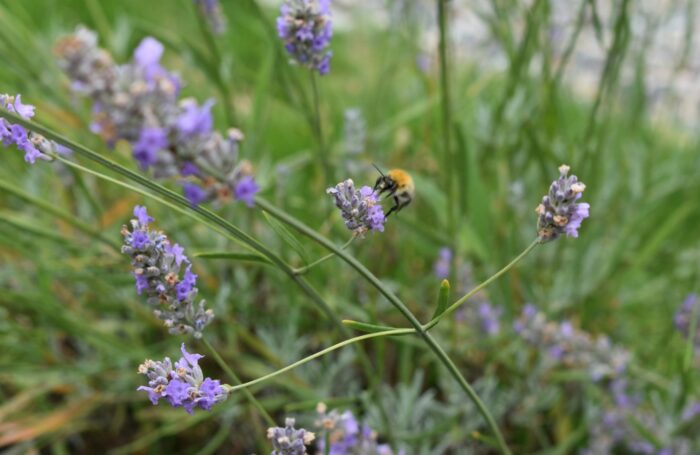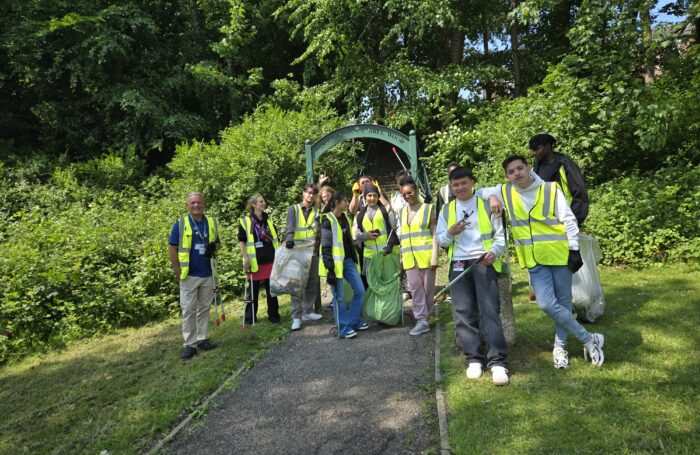From community groups and charities to businesses and schools, we believe that everyone has a role to play in helping nature recovery across Greater Manchester. We’ll be shining a spotlight on the passionate individuals who are already leading the way – our Local Nature Champions.
Daniell Musaheb is group co-founder and partnership & media manager at Ardwick Climate Action.
Tell us about your project.
Ardwick Climate Action’s mission is to protect our local environment through grassroots advocacy that engages the local community.
I’d say that our work encompasses the renewing of green spaces, monitoring pollution levels, climate advocacy through community engagement. Ultimately, it’s clear that the climate crisis is now unavoidable, so it is down to every single one of us to play our part. We see community action as the sole driver and catalyst to making this happen.
Ardwick is one of the most deprived areas in the country, seeing little action to retain its diminishing green spaces. This has contributed to the local area seeing a loss of around 65% of local biodiversity. We aim to regenerate and rewild areas for the community, offering a series of green spaces that serve to educate and engage local people.
One of our key projects is Ardwick Stepping Stones, which we are due to complete soon and was backed by the Greater Manchester Green Spaces Fund. It is establishing connected green spaces between Ardwick and the University of Manchester, creating a nature rich corridor and new and improved habits for wildlife and people. It is bringing residents, local groups and key partners together in a series of events which also highlight wider environmental concerns and raise awareness of the climate emergency. We’ve developed ten sites across the local area as part of the project, helping protect and improve our very delicate local biosphere.

We focus on something we call “positive planting”. Every plant species that we use is assessed so that we can fully understand the impact on local biodiversity. One example is bees: Manchester’s key pollinator, and indeed worldwide, isn’t actually hive bees, it’s solitary male bees. These bees do most of the work, so we planted orchards and handpicked species of plants that specifically support their needs and other pollinators to aid dwindling pollinator populations.
How did you first get into nature recovery?
I had a very lucky upbringing in the sense that I was born and raised in rural Lancashire – the passage of time wasn’t really marked by a calendar, it was by the crops that were growing in the fields or the changing of the seasons.
On the flip side, I’ve felt the detachment of suddenly finding yourself in an urban environment devoid of nature. The real thing that woke me up to this – as it did for many people – was the COVID pandemic. When COVID hit I was living in London, having graduated from film school with loads of prospects ahead of me. All that was wiped out pretty much overnight, and I found myself incredibly depressed. In the end I had to move back home because I had no savings and was really struggling with my mental health.
I was really down, and the thing that picked me back up was a friend who owns a landscape gardening company. He said asked if I’d like to come and do a day a week working with him, getting out and stuck into nature. That quickly turned into five days a week, an experience completely different to anything I’d set out to do in my life to that point. I love how it’s not a short-term thing, it’s something that takes a lot of work, time and care, even if you’re just growing something to eat for the next year.
I absolutely adored it – I’d never been around it a commercial capacity before, and nothing has ever worked like that in terms of boosting my mental wellbeing. So I’ve seen first-hand just how transformational being out and about in nature can be.

How did Ardwick Climate Action come together?
I think we’re all very aware that the climate crisis, biodiversity crisis and everything playing into that is at a very critical point at the minute in terms of what’s needed to change things for the better. But I suppose a lot of my motivations can be traced back to my background is a journalist – my role often puts me in a very privileged position in the sense that I have a seat at the table and I get to chew the ear off some of the most influential people working in nature, from UN leaders to people who have been born into grassroots activism. I often get to hear firsthand how this vast swathe of people got started, and their stories are always rooted in grassroots activism. One UN delegate once said something to me like “words are powerful, but actions are more” and I kept thinking about how true that was. And so I’ve been looking to get engaged in community-driven, grassroots action locally for a long, long time.
And then I had a real chance meeting with Choel Cartwright, who is one of the other co-founders of the group. She actually lives in the same block of the apartments from me, and we ended up talking about how involved she was in local nature recovery and that she needed help on promotion for the group for some upcoming events. So I came in to help with that initially, shining a light on what the group was doing through PR.
From there it all snowballed, to the point where we’ve all learned an incredible amount going through our first year, leading to our anniversary event in October 2023. I think we’ve all been amazed at what just four people can achieve. It does take a lot of passion and drive to get you through, but ultimately that’s kind of what’s needed if we’re going to tackle the impact of climate change head on.
Why do you think it’s important more people get involved in nature?
I think that when you look at Manchester and the various ways that the city is developing, greenspaces are not a critical consideration a lot of the time, especially in construction. So if you enjoy the green spaces that you do have access to, you have to make that known. I advise any community to work on them; if greenspaces aren’t viewed as a community asset then ultimately they are all too often viewed as being up for grabs by developers. We’ve seen that a lot in Ardwick, for example. My pitch would be that if you enjoy your green space and you want to see legacy preservation of it, there’s got to be work on a community basis that enshrines its importance locally.
Green spaces in the city centre itself are relatively few and far between. And whilst it’s great that Biodiversity Net Gain will compel developers to consider greenspace when planning their schemes, I still think it’s overlooked, a potential tool for greenwashing and inevitable that development will often have a disruptive impact on local green spaces. Having been privy to two major multi-billion pound developments in Manchester – one agreed and one going through the planning stages – there are clear inadequacies in landscape planning on the sites, even when developers want to have a positive impact. This includes little to no understanding of local biodiversity woven into plans, with nothing that works to support and enhance existing nature on the site. There are simple tools to aid this, such as bio-blitzes and planting of both male and female plants – developers often only plant male species for example, as it mitigates waste on site and lessens the cost of maintenance.
That’s where the likes of Ardwick Climate Action come in, because it’s the little pockets of green spaces that we and other groups cultivate that really reflect the needs of the local community and help ensure that high quality greenspace is available and accessible for all.
So I think my resounding message would be: if you enjoy the spaces you have, show an active interest in them because they can all too easily be taken away. We’re all fallible to being too passive with nature at times, to taking it for granted. But we’re increasingly understanding that it needs to be defended – and that’s a role that anyone and everyone can play.
What do you think is the single greatest priority for nature recovery in Greater Manchester?
The main thing for me would be getting nature established as the core priority when developing in the city-region. We’ll always need buildings, we all need somewhere to live – but surely there’s a better way to go about it, where we adopt a sort of natural contract or protocol with the natural environment that takes into consideration what nature is already there and strives to find ways to help it thrive alongside us.

This would be almost a case of providing nature with the same sort of rights that animals receive. Why can’t we then take that leap further and enter into this contract with nature?
I think having a sort of a consortium that actively looked at all this would culminate in better planning in infrastructure. The appetite is there: we are already seeing farmers step up across the UK in terms of sustainable farming now and different practices.
Another key point is that a fully centralised approach won’t necessarily work. The exact reasons for the biodiversity crisis in Greater Manchester will vary from district to district, and will be completely different to those of the Scottish Highlands, for example.
Development in the city-region isn’t going to stop. So if I could make one thing happen, it would be to put in place some sort of unifying agreement between city-region leadership and Manchester developers and then follow that as policy law to ensure that everything being done in the city has the consideration of nature at its heart.
What’s next for Ardwick Climate Action?
Our main project for the year ahead is a joint public engagement and research site, set on consecrated grounds of St. Saviours, a former church. Titled “The Lydia Becker Past, Present and Future Garden”, it will form a new public space for the community to enjoy, alongside exploring how we’re going to be affected by the sort of warming that is on the way in the UK. It also pays homage to the iconic suffragette and amateur scientist, Lydia Becker. We are working with our partner Manchester Museum to study her botany samples housed at the institution to use in the creation of a wildflower meadow on the site. We’re also running the whole site as a test project for non-native plant species that can be assessed over a long period of time to collect data about what we could then introduce into UK biospheres should native plant species fail due to climate change.
It will also act as a site encouraging people back into nature. One of the questions that I ponder a lot is about how we can engage youth demographics back into nature, when they have been growing up with a screen in front of them. So the whole site is being designed with a digital overlay that complements the planting and other physical elements of the site. It will see FX students from the Manchester College studying the former church, which was one of the last year Grecian classical buildings to be built in Manchester – it would probably be a listed building if it still stood. The building is being rendered into 3D by The Manchester College, providing an augmented reality overlay for visitors that will provide a truly immersive experience, bringing the digital into the natural world. This project will link the history of the area to the current state of ecology and nature today.
How can people get involved in the project?
You can follow our various social media profiles for updates about our activity – we always post about upcoming events and opportunities on there, so it’s a good way to stay on the pulse:
Find out more about our plan for nature recovery
Greater Manchester is currently developing its Local Nature Recovery Strategy, which will set out a blueprint for a more liveable city-region, with fairer access to green space for all.
Find out more including ways to get involved on our nature recovery webpage.


